|
BULB LOG 02 --- 10th January 2007

Aphids
It is extremely important to be ever vigilant and check your bulbs for aphids which can strike at any time, especially when we get mild conditions in the winter. Just this week I found these newly hatched leaf suckers lined up along the leaf behind their mother.
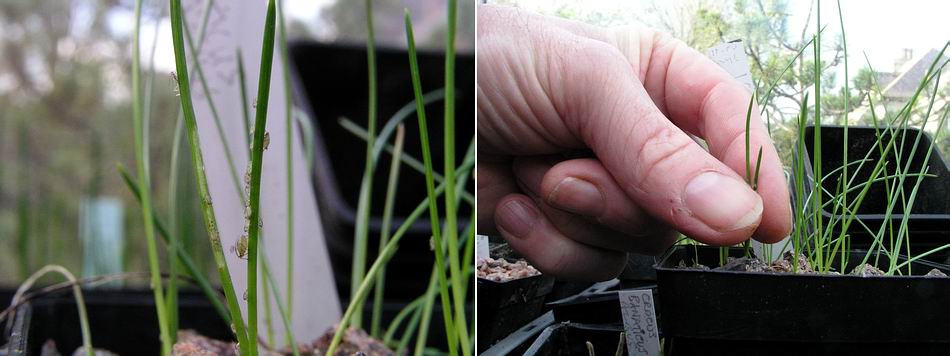
Organic control
If you only have a small number of bulbs then you can rub the green fly between finger and thumb and that is organic as you can get. I always wipe them out this way as soon as I see them. The biggest threat from the aphids is not that they will suck some sap from the bulbs but that they can be the vector that spreads virus to and through my collection and they must not be allowed to build up. You also need to be aware that if you wipe the aphids off several different plants you could also pass any virus on from one plant to another so beware. I also follow up the organic finger and thumb method with a spray of a systemic insecticide.
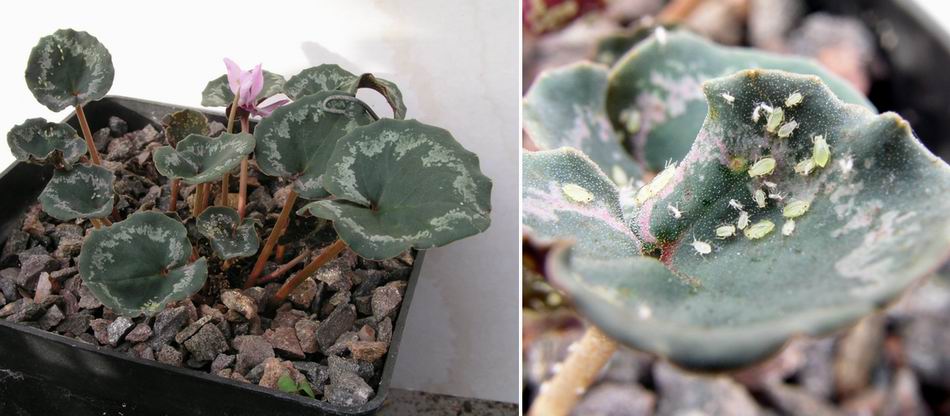
Aphids on cyclamen
The green fly often over winter on evergreen plants, like this cyclamen, so you need to be extra observant and check them on a very regular basis especially during warmer periods so you can deal with them before they get too big a hold.
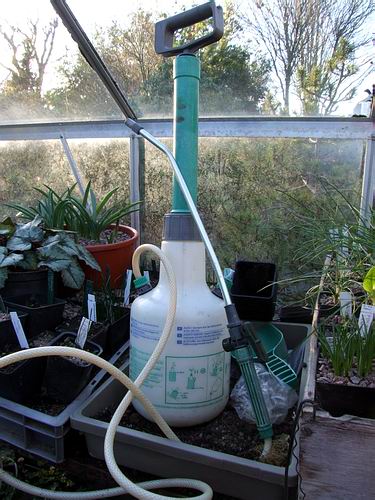
Lance sprayer
I have no guilt in admitting that I will use a systemic insecticide under glass and in the frames. The active ingredients contained in the products that are available to home gardeners in the UK are Imidichloprid and Bifenthryn. Wiping aphids off with your fingers is a short term measure because there will always be more lurking just below the surface waiting to emerge - that is why I use a systemic insecticide that will act through the plants system and poison any aphids that I have missed.
The contact and biological controls are fine but do not tackle the aphids that attack the stems and leaves just below the soil and the systemic spray remains active in the plants system giving it protection for up to eight weeks. You could say that to get the lethal dose the aphids have already done the damage as they have had to suck the sap but they are prevented from moving from plant to plant and cross infecting. We will never be able to keep completely clear of aphids so we are just working to contain and minimise the possible harmful effects they may have.
I am extremely environmentally aware and of course worried about the effects to my own health that using these toxic chemicals can cause. You should always follow the instructions on the product you are using and never use it or adapt it in any other way.
You should also be very aware of the harm these substances can cause to the environment and use them very sparingly.
One mix to fill my lance sprayer with one litre requires just 5mml of the insecticide, I use the finest spray that I can select and pass quickly over the new emerging leaves so that they are coated with the finest mist of liquid. By spraying early, as the new growths emerge, I can prevent any build up of aphids from occurring which would require using a great deal more of the harmful chemicals also the effect is active for at least 6 to 8 weeks. At the most I go through 4 mixes, some years only 2. This gives me a maximium annual usage of 20mml of the insecticide and as it is systemic and drawn into the bulbs system and hence into the aphids very little is not used up.
I always wear disposable plastic gloves and a mask when necessary to avoid any contact or inhalation of the mist. With a large collection of bulbs like ours that has taken years to build up I have no guilt at all in the tiny amount of harmful and toxic chemicals that I use to defend and preserve it. I believe that my life time's use of insecticide will cause far less harm to the environment than that caused by the production and eventual disposal of the PC that I am using to post this message.
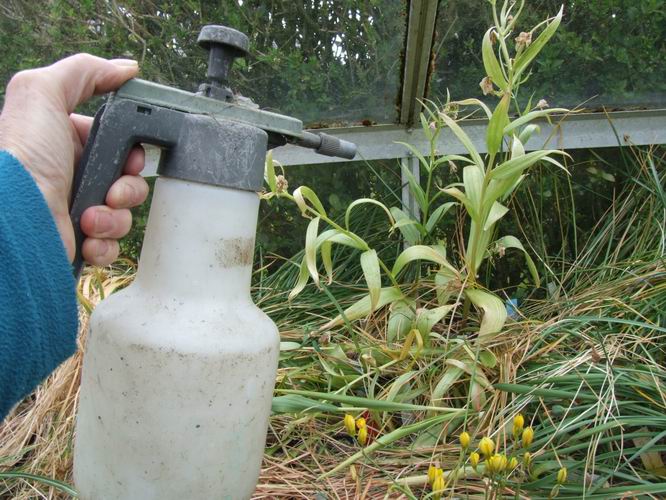
Hand sprayer
I do not like using hand held sprayers like this for insecticide for two reasons firstly I am too close to the spray and can get contaminated more readily and secondly you cannot pass the spray quickly through the foliage as well as you can with the lance type of sprayer.
I never use insecticides in the open garden where I let nature make the balance sometimes I assist with my finger and thumb or with a jet of water to wash the bugs off.
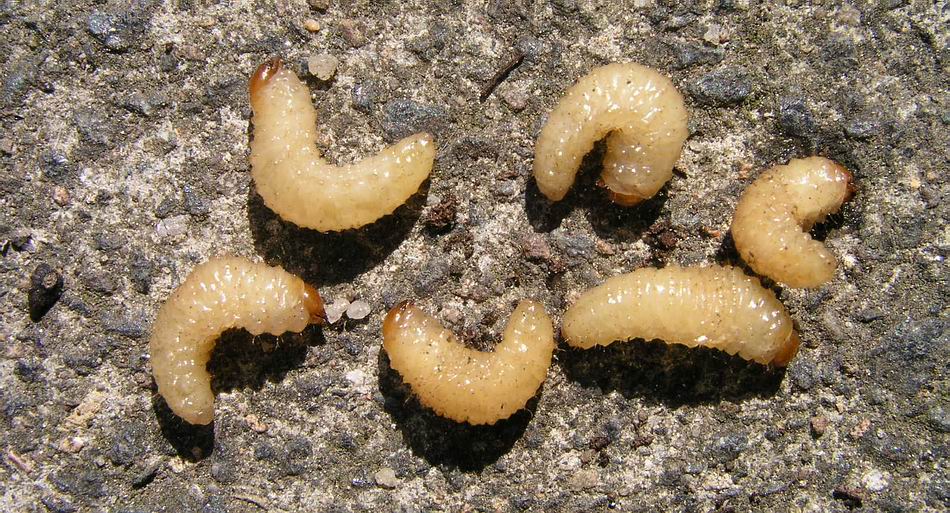
Vine weevil grubs
Provado is one of the few insecticides available to home gardeners in the UK - it is based on Imidichloprid which will also control vine weevil. I do not find vine weevils a big problem with most of the bulbs we grow except cyclamen.
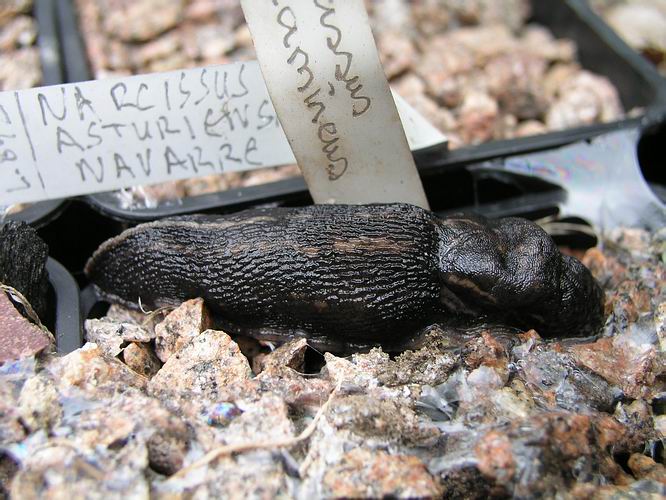
Slugs
While I am on the subject of pests I will just run through some of the others that affect us. Slugs of all shapes and sizes want to devour our bulbs and can be especially devastating in the seed frames where one slug can wipe out an entire pot full of seedlings in a few hours.
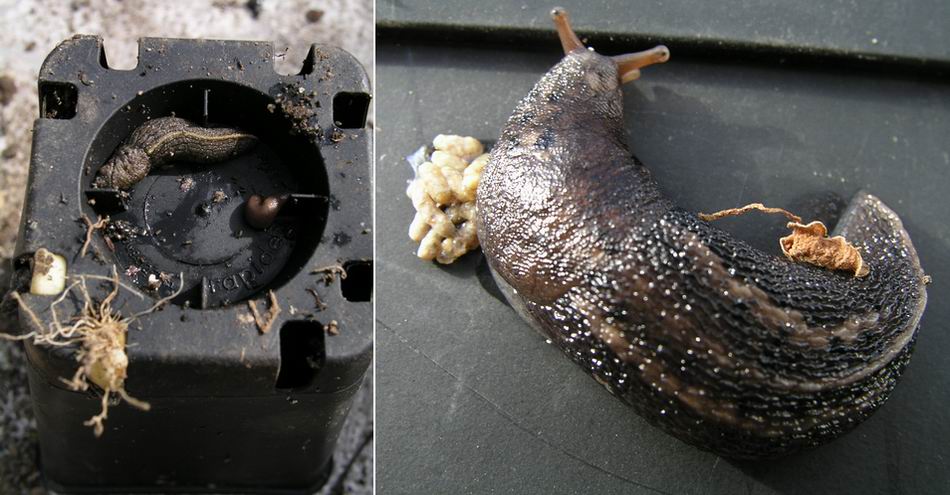
Slugs on pots
One way of minimising slugs is to be aware of where they hide during the day so you can collect them up. Underneath pots is a favourite place for them to lurk.

Frog
We have a good population of frogs in the garden and they certainly eat some slugs but like hedgehogs they much prefer to chomp on an earth worm rather than a slimy slug - and I can't blame them!
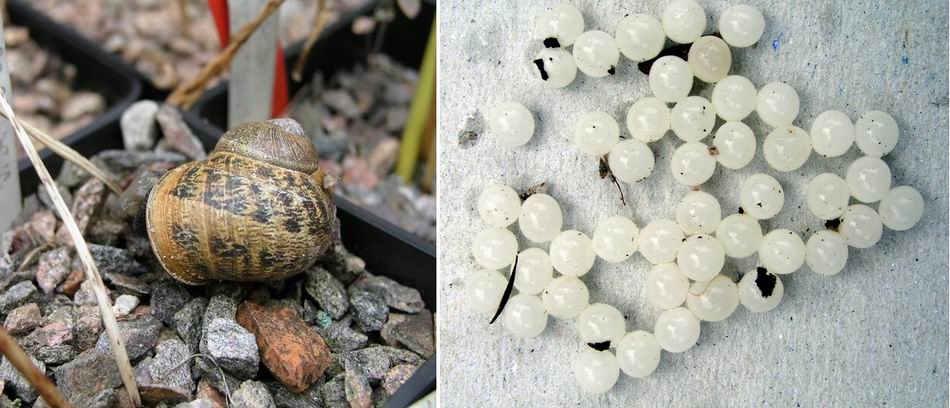
Snail and eggs
It is a similar challenge with snails - searching them out and watching for their eggs which they lay just below the surface of the compost often close to the edges in pots or troughs.
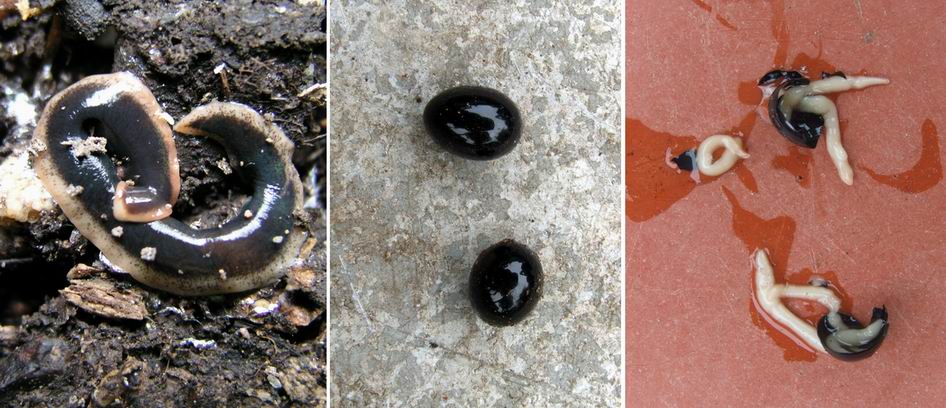
New Zealand flat worm
While not a problem in that it does not eat or attack our plants, the New Zealand flat worm is an alien species that preys on our earth worms. They lay eggs that are like shiny blackcurrant berries that have a brittle shell. If you break them as they near maturity you will see that each egg does not contain just one flat worm but several. The best way to control these is to lay black plastic bags, with a bit of sand in them to weigh them down, on the earth and the cool moist conditions will attract flat worms during the day. Watch that you do not handle them with bare hands as it is said that some people can have an unpleasant reaction to the slime on their bodies. I do not believe that they eat nearly as many earth worms in our garden as the frogs, hedgehogs or black birds and as we add masses of organic material to our garden every year we have a healthy population of worms.
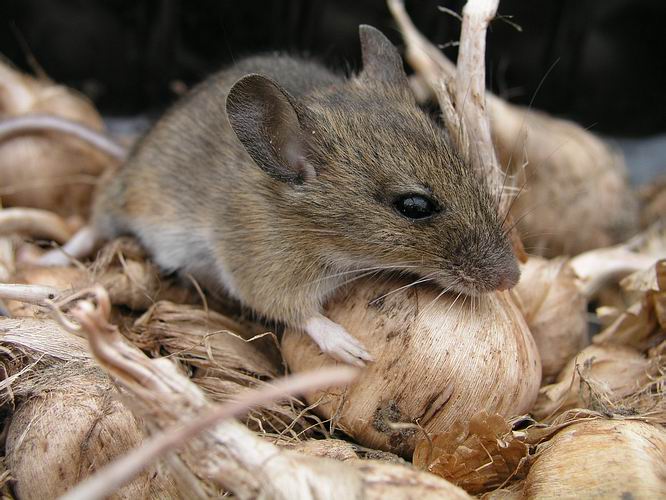
Mice
It is the same with mice which are mostly content eating from the bird food - we do set traps to keep the mouse population from getting out of hand altogether.

Weld mesh
When I pot up crocus corms I place a piece of weld mesh on top of the compost before I add the gravel top dressing, this helps prevent the mice getting at the corms.
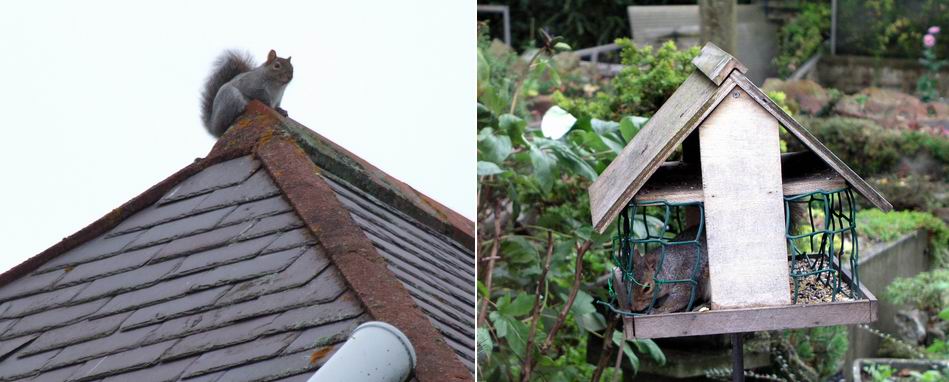
Squirrel
Now on to the bigger pests such as the Grey Squirrel which mostly eat the bird food that we put out but they have occasionally gone for our crocus corms so we do not encourage them at all and always chase them away when we see them.
I accept that we will never be able to get rid of all the pests that attack our plants, and you could argue that would not be a desirable thing to do, but we do need to keep a balance so that they do not devastate all that we have worked so long and hard to build up.
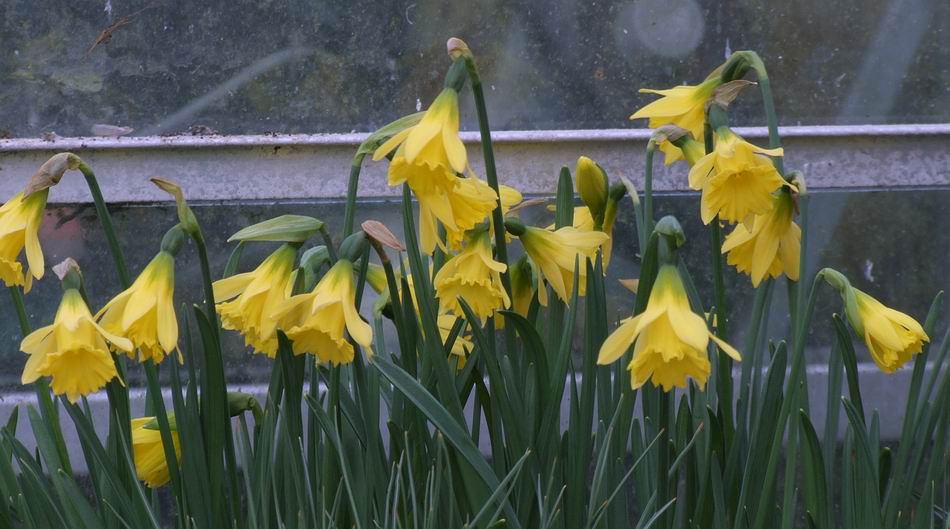
Narcissus 'Cedric Morris'
Just to end on a happy note and to say that we have a lot more flowers than pests, here are the ever reliable and extremely long lasting flowers of Narcissus 'Cedric Morris'.
^ back to the top ^
|

